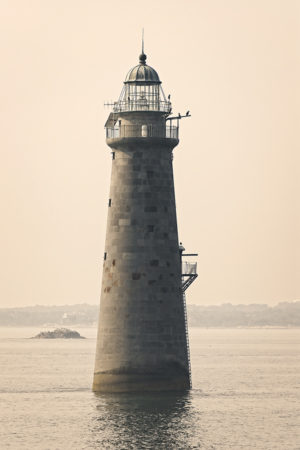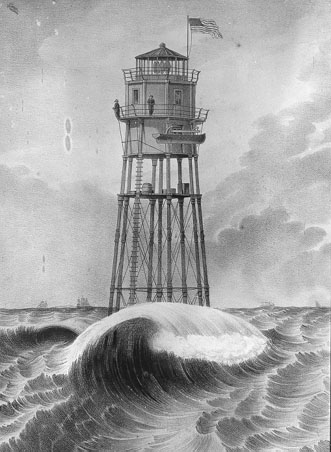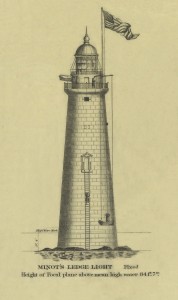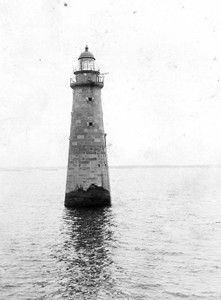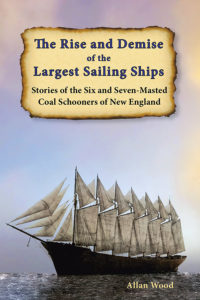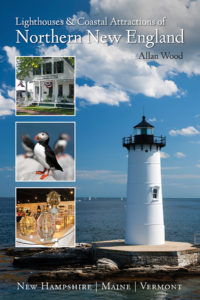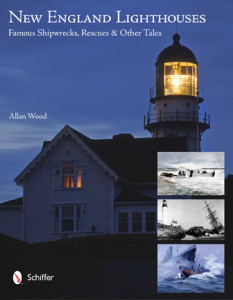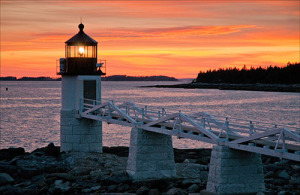After the Destruction of the “Lighthouse Storm” in Massachusetts, Ghost Keepers Still Assisting Mariners Around Minot’s Ledge Lighthouse
Minot’s Ledge Lighthouse lies within a dangerous group of rocky ledges called the Cohasset Rocks between the “south shore” towns of Cohasset and Scituate, located south of Boston, Massachusetts. Before the lighthouse was built in 1850, many shipwrecks were recorded from the dangerous rocks, with many lives lost. When the lighthouse was built on a small rocky ledge surrounded by water, it had its share of bad luck for many of those who tried to tend its lantern. It took three years to build from 1847-1850 as an engineering feat consisting of an enormous 30-ton lantern perched on a huge 87-foot skeletal iron tower to protect the structure and its keepers against the strong winds and waves. It was known as the “Iron Lighthouse” from its construction, and much praise was given to its engineers. The concept was that fierce winds and waves could pass through instead of constantly smashing a solid, enclosed structure, as was the construction of most other lighthouse towers. It was lit on January 1, 1850. The first keeper was Isaac Dunham, with his son Issac A. Dunham, who was the assistant keeper to his father. Both quit after ten months at Minot’s Ledge Light because they felt the structure was inadequately built and feared for their safety. Constant vibrations from the pounding seas and winds caused noticeable cracks in the locations where holes were drilled for the pillars.
The Lighthouse Storm of the Century
One of the worst storms in New England’s recorded history occurred on Monday, April 14, 1851, and continued through that Saturday, April 19th. This storm that entered the New England coastline on a Monday morning had all the ingredients of high winds, rain, hail, and even snow over nearly a week to cause massive devastation all along the eastern seaboard and inland of central and southern New England.
Just before the storm hit on Monday, April 14, 1851, Keeper Bennett was ordered to come ashore to gather much-needed supplies and had left his two young assistants, Joseph Antoine and Joseph Wilson, to manage and tend the lighthouse in his absence. Joseph Wilson was a proud sailor and was reported in March, before the storm, in response to inquiries from reporters as to the safety of the lighthouse, that he would stay as long as Bennett would stay and that only when they would leave the lighthouse, it would be too dangerous for anyone else to take over. Joseph Antoine was a Portuguese sailor with relatives in Cohasset and loved working at the lighthouse. The storm suddenly came upon the Massachusetts coast that Monday afternoon with a vengeance, preventing the two men from leaving their post.
By Wednesday afternoon, April 16, the seas were still surging and pounding Minot’s Ledge Light. The only way to reach the shore would have been to descend the 87-foot structure down a rope outside to their small boat and battle the devastating waves for miles to reach the mainland. It was an impossible task as the two had no choice but to ride out the storm and hopefully survive.
On April 17, 1851, winds were recorded to be gusting at a hurricane force of over 100 miles per hour. It was one of the most destructive and powerful storms ever recorded. The waves pounded the structure, causing the lamp at Minot’s Lighthouse to go out at around 10 p.m. The tower succumbed to the pounding huge waves, tidal surges, and hurricane-force wind gusts and tumbled over, crashing over the rocks of Minot’s Ledge. There was nothing left of the structure. The following day, Antoine’s body was discovered washed ashore at Nantasket Beach, while Wilson’s body was later found on nearby Gull Island.
By Sunday, April 20, the storm had finally cleared away from its near weeklong devastation in New England.
The storm was later named the “Lighthouse Storm,” as it was directly responsible for the destruction of Minot’s Ledge Lighthouse.
A lightship was brought in temporarily, and new construction began in 1855 of a stone tower made of granite. It was finally completed years later in 1860, as one of the most expensive lighthouses in the nation’s history. It is still considered to be one of the top engineering feats of the old United States Lighthouse Service.
In 2000, a granite memorial to Joseph Antoine and Joseph Wilson was erected to honor the two men on Government Island.
Hauntings at Minot’s Ledge Light After the Tragedy
Since the tragedy, Minot’s Ledge Lighthouse is believed to be haunted by the two assistant keepers. Many fishermen swear during stormy weather, they’ve seen a man hanging from a ladder on the side of the tower, screaming, “Stay away, stay away,” in Portuguese (Joe Antoine was Portuguese).
Both Joe Wilson and Joe Antoine had once worked out a method for signaling the end of the shift by making five loud taps that would echo up the very long stairway. After their deaths, other keepers stationed at Minot’s Ledge Lighthouse would report hearing the five taps echoing up through the stairs at the end of a shift with no one below to make the sounds.
Other keepers who stayed at the rebuilt granite lighthouse have reported seeing two shadowy figures of presumably the two assistant keepers in the lantern room in the middle of the night.
When birds would fly overhead many times, they would dirty the windows, which would take a good part of the day for the keeper to normally clean. Some other strange paranormal activities include cleaning these lighthouse windows of bird droppings. Some keepers have reported that the task would be mysteriously completed when they or their assistants would gather the material to clean the windows.
One keeper brought his cat to the tower for companionship. He would report that the cat acted very strangely near the lantern room, running around in circles and screeching.
Some keepers could not handle the isolation of the tower in its remote location surrounded by water. One keeper went crazy and slit his throat. Another went insane and was removed from the lighthouse in a straitjacket. The ringing of a phantom bell and the taps or knocks are still frequently heard at night.
Exploring the Cohasset Area Near the Lighthouse:
No boat tours are presently going out to the lighthouse due to its relatively remote location. Still, sometimes you can catch a ride with a fisherman or lobsterman if you offer to pay for the service out of the marina in Cohasset Harbor.
Cohasset is a friendly coastal town with museums, beaches, a nearby wooded reservation, and parks for hiking. The coastal shore route in this area, also known as the “Gold Coast,” provides many beautiful opulent homes and scenic coastal ocean views.
Nearby in Hull, The Hull Lifesaving Museum provides maritime exhibits and educational workshops and tours.
Enjoy,
Allan Wood
The Rise and Demise of the Largest Sailing Ships: Stories of the Six and Seven-Masted Coal Schooners of New England. In the early 1900s, New England shipbuilders constructed the world’s largest sailing ships amid social and political reforms. These giants were the ten original six-masted coal schooners and one colossal seven-masted vessel, built to carry massive quantities of coal and building supplies and measured longer than a football field! This book, balanced with plenty of color and vintage images, showcases the historical accounts that followed these mighty ships. Stories involve competitions, accidents, battling destructive storms, acts of heroism, and their final voyages.
Available in paperback, hard cover, and as an eBook for all devices.

Book – Lighthouses and Coastal Attractions in Southern New England: Connecticut, Rhode Island, Massachusetts
My 300-page book, Lighthouses and Coastal Attractions of Southern New England: Connecticut, Rhode Island, and Massachusetts, provides memorable human interest stories from each of the 92 lighthouses, along with plenty of indoor and outdoor coastal attractions you can explore. These include whale watching excursions, lighthouse tours, windjammer sailing tours and adventures, special parks and museums, and even lighthouses you can stay overnight. You’ll also find plenty of stories of shipwrecks and rescues. Lighthouses and their nearby attractions are divided into regions for weekly and weekend explorers. You’ll also find plenty of stories of hauntings around lighthouses, like the one mentioned above about the two lost Minot’s Ledge Light keepers.
My 300-page book, Lighthouses and Coastal Attractions of Northern New England: New Hampshire, Maine, and Vermont, provides special human interest stories from each of the 76 lighthouses, along with plenty of indoor and outdoor coastal attractions you can explore and tours. Lighthouses and their nearby attractions are divided into regions for weekly and weekend explorers. Attractions and tours also include whale watching tours, lighthouse tours, windjammer sailing tours and adventures, special parks and museums, and lighthouses you can stay overnight. There are also stories of haunted lighthouses in these regions.
Included are details of the destruction of the Minot’s Ledge Light during that harrowing storm, along with over 50 other stories in my book New England Lighthouses: Famous Shipwrecks, Rescues & Other Tales. This image-rich book also contains vintage images provided by the Coast Guard and various organizations and paintings by six famous artists of the Coast Guard.
You’ll find this book and the lighthouse tourism books from the publisher Schiffer Books or in many fine bookstores like Barnes and Noble.
Join, Learn, and Support The American Lighthouse Foundation
Copyright © Allan Wood Photography, do not reproduce without permission. All rights reserved.
